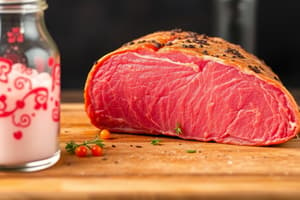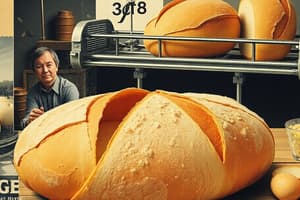Podcast
Questions and Answers
What is the primary focus of food science?
What is the primary focus of food science?
- Studying the properties and transformation of food (correct)
- Developing new food products
- Promoting healthy eating habits
- Marketing food products to consumers
Which of the following is NOT a key component of food composition?
Which of the following is NOT a key component of food composition?
- Carbohydrates
- Vitamins
- Fibers (correct)
- Proteins
Which of the following is an example of a food processing technique?
Which of the following is an example of a food processing technique?
- Harvesting fruits
- Freezing vegetables (correct)
- Growing vegetables
- Serving a meal
What is the main goal of food safety practices?
What is the main goal of food safety practices?
Which of these factors is NOT considered in assessing food quality?
Which of these factors is NOT considered in assessing food quality?
What is the main purpose of food preservation methods?
What is the main purpose of food preservation methods?
Which of the following is NOT a common food preservation method?
Which of the following is NOT a common food preservation method?
Why is food science considered a multidisciplinary field?
Why is food science considered a multidisciplinary field?
Which of the following is NOT a common food preservation technique?
Which of the following is NOT a common food preservation technique?
What is the primary purpose of food packaging?
What is the primary purpose of food packaging?
Which type of microorganism is NOT typically involved in food spoilage or illness?
Which type of microorganism is NOT typically involved in food spoilage or illness?
What is NOT a factor that influences consumer food choices?
What is NOT a factor that influences consumer food choices?
Flashcards
Food Science
Food Science
A multidisciplinary field studying food properties and handling.
Food Composition
Food Composition
The mixture of chemical substances in foods, including nutrients.
Carbohydrates
Carbohydrates
Nutrients providing energy; includes sugars, starches, fibers.
Proteins
Proteins
Signup and view all the flashcards
Lipids
Lipids
Signup and view all the flashcards
Food Processing
Food Processing
Signup and view all the flashcards
Food Safety
Food Safety
Signup and view all the flashcards
Food Preservation
Food Preservation
Signup and view all the flashcards
Food Preservation Techniques
Food Preservation Techniques
Signup and view all the flashcards
Food Packaging Purpose
Food Packaging Purpose
Signup and view all the flashcards
Functional Packaging Features
Functional Packaging Features
Signup and view all the flashcards
Food Microbiology Importance
Food Microbiology Importance
Signup and view all the flashcards
Consumer Behavior Factors
Consumer Behavior Factors
Signup and view all the flashcards
Study Notes
Introduction to Food Science
- Food science is a multidisciplinary field studying the physical, chemical, and biological properties of food.
- It focuses on food production, processing, storage, and consumption.
- It encompasses food safety, nutrition, preservation, and quality.
- Food scientists use scientific principles to improve food quality, safety, and nutritional value.
- Food science addresses consumer needs, preferences, and societal issues surrounding food.
Food Composition
- Foods are complex mixtures of various chemical substances.
- Key components include carbohydrates, proteins, lipids, vitamins, minerals, and water.
- Carbohydrates (sugars, starches, fibers) provide energy.
- Proteins (building blocks) form tissues and enzymes.
- Lipids (energy storage, insulation) regulate hormones.
- Vitamins and minerals are essential for bodily functions.
- Water is crucial for biological processes and nutrient transport.
Food Processing
- Food processing alters raw food attributes physically, chemically, and biologically.
- Techniques include freezing, canning, drying, fermentation, and irradiation.
- Processing enhances safety, preservation, palatability, texture, nutritional content, and convenience.
- Processing methods depend on desired final product characteristics.
Food Safety
- Food safety is crucial for preventing foodborne illnesses.
- It involves managing factors causing contamination and spoilage.
- Microbial contamination (bacteria, viruses, parasites) is a significant concern.
- Temperature control, hygiene practices, and proper handling prevent illness.
- Home food safety practices (preparation, storage, reheating) are vital.
Food Quality
- Food quality encompasses sensory attributes (color, flavor, texture, aroma), nutritional value, safety, and content.
- Consumer perceptions of food quality influence purchasing decisions.
- Objective and subjective metrics, using expert panels and consumer feedback, assess quality.
Food Preservation
- Food preservation extends product shelf life.
- It prevents spoilage, microbial growth, and enzymatic reactions.
- Techniques include refrigeration, freezing, canning, drying, and irradiation.
- Preservation methods affect nutritional value, texture, and sensory characteristics.
Food Packaging
- Food packaging protects food from oxygen, light, and moisture.
- It increases shelf life.
- Packaging materials (plastics, paper, metals) are important.
- Functional packaging (temperature-sensitive inks, active components) enhances food protection.
Food Microbiology
- Food microbiology studies food microorganisms, their growth, survival, effects on quality and safety.
- Bacteria, fungi, yeasts, and molds may cause spoilage or illness.
- Understanding microbial behavior helps design preservation methods.
Nutritional Aspects of Food
- Nutrition is an integral part of food science.
- Food scientists investigate food nutritional value and its health effects.
- They develop dietary recommendations and guidelines based on research.
- Research links diet, nutrition, and health outcomes.
Consumer Behavior
- Consumer food consumption behavior is frequently studied.
- Taste preferences, cultural influences, and economic factors affect choices.
- Understanding consumer behavior assists in developing effective marketing strategies.
Studying That Suits You
Use AI to generate personalized quizzes and flashcards to suit your learning preferences.



